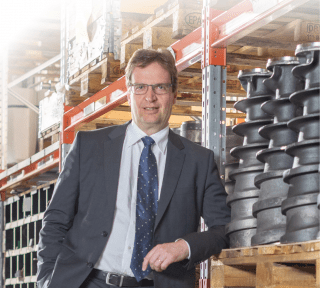Providing the maximum added value for our customer is always our number one priority, Mats Jungar summarises Elematic’s strategy.
Delivering on this promise, a new version of Elematic’s core product, Extruder E9, is serving construction business with significantly better productivity.
“With the latest technology is possible to get 50 percent more output for the same investment compared to earlier. Moreover, up to 10 percent savings in labour costs are achievable with well-functioning production planning tools such as our FloorMES. These are tools for our customers to boost their competitiveness”, Jungar says.
But focus on customers is not only about offering development. It is also about developing the whole customer journey from the very first touchpoint all the way to the end of the factory lifecycle. An example from the sales part is the development of quotations. “We can now offer factory layout drawings in 3D format which provides a highly visual, concrete and realistic picture on how the different pieces of a production line and its surroundings fall together.”
“This strengthens our service to customers at a key point in their decision-making process.”
Moreover, the Elematic Customer Service team gives their contribution to strengthen the customer experience. A team of spare part sales, warehouse, sourcing and systems professionals have been developing new processes for spare and wear parts delivery to bring the delivery accuracy to a whole new level.
Generational change to hasten digitalisation
To stay at the forefront of digitalisation, Elematic started a brand-new software unit in February. Located in Tampere, Finland, the team of software developers are developing intelligent software to ensure seamless data flow from design to production.
“The construction business has always been conservative and is adapting to digitalisation slowly. While the design process is already mainly digitalised, the data flow to production needs to be more intelligent. The new software aims to cover that shadow region while responding to our customers’ needs”, Jungar explains.
“Digitalisation will ramp up in speed within the next few years, as required increase of productivity and generation change happens within construction companies. Younger generations will be able to utilise the countless possibilities offered by digitalisation to improve the operations of precast factories and efficiency.”
To further develop automation in the industry, Elematic have in the pipeline a new version of ERP for running a digitalised precast factory. The Plant Control ERP – which includes tools production planning, execution and monitoring – bridges different work processes digitally, thus enabling fully automated production together with a new generation of equipment.
“We believe that digitalisation is the solution to ensuring product quality. With fully automated machines, the risks of human errors can be eliminated. At the same time, overall factory safety will be improved.”
The construction industry is still struggling with the restricted availability of professionals. The lack of educated workers may create quality challenges on construction sites. This emphasises the importance of relying on automated processes.
5 400 tonnes less C02-emissions
Environmental issues are constantly challenging the construction industry to develop. The use of natural resources, the amount of emissions and the environmental impact in general – there are various aspects to consider.
“Increasing environmental regulations are constantly creating new markets for the prefabricated industry”, Jungar highlights.
Pre-stressed hollow-core slabs stand as a very good example of an efficient use of raw materials in prefabrication: they provide savings of up to 45 percent in concrete compared with a plain cast-in-situ reinforced slab. At the same time, the amount of pre-stressing steel can be cut by 30 percent because of the lower self-weight. For an average apartment, this means savings of 14.4 tons of concrete and 275 kg steel.
In general, factory production saves raw materials, and with the new solutions focusing on this, the raw material efficiency is improving all the time. A recent development at Elematic in this field is the new automatic Modifier E9 for marking and digging openings to hollow core slabs. Forming an efficient working unit with Extruder E9, the machine features fully automatic concrete recycling that enables concrete removed from openings to be recycled back into the hollow-core slab production process. As a result, an average hollow-core factory, producing 300 000 m2 annually, can decrease the amount of C02-emissions by 5 400 tonnes.
Urbanisation continues to create markets
Nordic countries and the Netherlands are currently the world leaders in prefabricated building. There has been a steady growth of the global precast business for a long time and the trend has been driven by the urbanization and need for mechanization in construction industry. Urbanisation, which continues to be a strong megatrend across the globe, creates increased demand for prefabricated technology also in the future.
“The coronavirus is affecting the construction business temporarily. In the long run, however, the use of precast concrete technology is increasing as productivity and digitalization is needed to respond the emerging need of decent housing in the developing countries”, Mats Jungar predicts.

